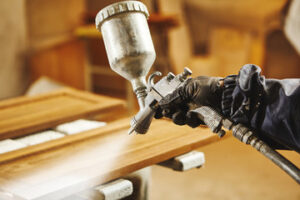A roof is an essential part of any home or building. The roof protects the rest of the structure and its inhabitants from rain, snow, and sun.
Roofing is an involved process, and knowing the basics can help homeowners make informed decisions when choosing materials or understanding their warranties. Read on to learn more about the basics of roofing. Contact Buckeye Roofing of Columbus now!

The strength and durability of plywood makes it ideal for roofing. However, it is also a versatile material for many different applications in construction and DIY projects. Plywood comes in a variety of thicknesses and grades, each with different properties. The type of wood used and the method of manufacturing are important to consider when choosing plywood for a particular project.
Generally speaking, plywood consists of layers of wood veneers bonded together to produce a flat sheet. It has a great range of uses, from concrete formwork to interior paneling. The layered structure of plywood provides exceptional strength, especially when compared to solid wood. Its high tensile strength distributes force over a larger area, which helps to reduce impact resistance and stress. Its resistance to shearing and bending is also a benefit when it comes to roofing.
Some varieties of plywood are treated with resins and other materials to provide extra benefits. These additions can increase the waterproof qualities and help to resist fungus. They can also improve the durability and fire resistance of the plywood. Plywood can be made from a variety of softwood and hardwoods, or a combination of both. Softwoods are typically taken from pine, fir, or cedar, while hard woods come from maples, oaks, and ash. Increasingly popular is composite plywood, which combines a core of solid wood pieces with a wood veneer on either side.
Plywood is manufactured through a meticulous process that starts with the careful selection of logs and ends with a finished product that can withstand numerous environmental challenges. The choice of logs, the precision of slicing veneers, and the use of appropriate adhesives all play a role in the quality of plywood.
While it can be a versatile and cost-effective material, plywood requires more maintenance than other roofing materials. It should be inspected regularly for signs of water damage, mold, or other issues that can compromise its structural integrity. Plywood should also be kept clear of debris and pests to minimize wear and tear.
When shopping for plywood, it is important to know what the product is intended for and to assess the thickness, grade, and color of each sheet. Higher-grade plywood has fewer blemishes and is less expensive than lower-grade sheets. It is also recommended to choose a plywood that is labeled with the ANSI grade, as this indicates it has passed a rigorous test for quality and durability.
Shingles
A shingle is a thin, protective covering for the top of your home’s roof. They can be made of different materials, shapes, colors, and textures to suit your specific needs. Typically, they’re designed to protect the underlying roof from water penetration.
The most common shingles are paper or fiberglass asphalt shingles. Wood shingles are also available but they’re usually more expensive than their asphalt counterparts. Both shingles are coated with colored granules to give them a more attractive appearance. The granules also serve a number of other functions, including providing UV protection for the shingles and increasing their fire resistance.
Most shingles are held together by a strip of material called roofing felt, which is placed on the roof deck before the shingle material goes up. This acts as a first line of defense against water entering the roof if the shingles are damaged by weather or other factors.
Over time, shingles can be damaged by wind, rain, snow, hail, and other elements that can lift them off the roof. These elements can then enter the house and cause damage over time. The shingles themselves aren’t as resistant to these forces as they could be, but the underlying plywood is. The shingles and plywood can also leak through the joints, flashing, and nail holes if they aren’t properly installed.
A good roofer will pay special attention to the placement of shingles. This involves proper exposure (the extending part of the shingle above its underlying material) and offset (the lateral distance between joints in successive courses of shingles, sometimes called stagger or edge-to-edge spacing). Proper nail placement is also important. Nails should be driven flush with, but not cut into, the shingle to reduce the risk of moisture penetration.
Some shingles are designed with closed valleys, which make them less vulnerable to water penetration through the edges of the roof. Those that aren’t can allow water to seep under the shingles where it may rot the underlying roof building materials and eventually affect ceilings and paint inside the house. For this reason, it’s generally recommended to use a closed valley whenever possible.
Metal
Metal is a popular choice for commercial and industrial roofing due to its durability, weather resistance, and long lifespan. It is also an attractive option that provides a modern look for homes and buildings. While it may seem expensive at first, a metal roof will last for decades and pay for itself in the long run when compared to other types of roofing materials.
Metal roofing is available in a variety of colors and styles. It can be made from steel, aluminum, zinc, or copper. Each type of metal has its own unique benefits. Steel is one of the strongest materials in the world and can withstand a variety of attacks from physical, chemical, and environmental threats. It is also highly versatile and can be molded to create different designs.
Aluminum is a lightweight material that offers corrosion resistance. It is also easy to work with and is available in a wide range of colors. It is a good choice for coastal and humid climates, though it is more prone to hail damage than steel. Zinc is a sustainable material that requires less energy than processing copper and steel. It is also extremely durable and ages into a beautiful green patina over time.
Both galvanized and galvalume steel have a protective coating that prevents rusting. They are also less expensive than other metals and can be produced in various thicknesses. Galvalume has a blend of aluminum and zinc that strengthens it and helps prevent rusting even more.
There are several myths surrounding metal roofing. For example, some people believe that metal roofs attract lightning. While it is true that metal structures tend to be the most common targets for lightning strikes, they are no more likely to attract lightning than other structures like telephone poles and trees. In addition, if a lightning strike does occur on a metal structure, it will disperse the energy safely throughout the roof instead of setting fire to it like asphalt shingles do.
The most common way to use metal in a roof is to place it on open framing, or to attach it to the purlins (additional support beams added to the roof frame). However, some architects also choose to use it to construct structural metal roofs, which are supported by joists and are attached to the main frames of the building.
Tile
Tile roofing adds a unique blend of beauty, energy efficiency, and durability to your home. Although more expensive than shingles, the long lifespan of tile roofs makes them a wise investment. Additionally, tile can enhance a property’s curb appeal and increase its value.
Originally, tiles were handmade, using clay that was molded to the desired shape and then fired in a kiln. The process was time-consuming and labor intensive, but the resulting tiles were extremely durable. As technological advancements and manufacturing processes improved, tile production became more efficient and cost-effective. The 19th century saw the introduction of machines that could extrude clay into shapes through dies, a process that significantly reduced the time required for tile production.
Modern tile roofing is comprised of concrete, which has been mixed with sand and larger aggregates such as gravel to form a highly durable material that can be formed into various styles and colors. In addition to reducing construction and installation time, concrete tile is also a lightweight alternative to clay tile. The combination of these factors makes it a popular choice for residential and commercial roofs.
If you choose to use tile for your roof, it is important to consider the type of sheathing that will be used underneath. You will need to use a sheathing that is strong enough to support the loads of the tiles, and should consult with your local building official for specific requirements.
Once the sheathing is in place, it’s time to start installing the tiles. First, you’ll need to determine the spacing of the battens. Ensure that you have a good amount of space between the tiles, and be sure to leave room for expansion and contraction.
It’s a good idea to have your roof inspected after a heavy rainstorm, as the water pressure may be high enough to pull the tiles off of the sheathing. If you do find any loose or damaged tiles, it’s a good idea to have them replaced as soon as possible.
You’ll also need to install ridge pieces and terminals on your roof to seal the gaps between tiles. Typically, these are decorative in nature and can take the form of statues or other ornamentation such as flowers and plants. In Japan, the onigawara is an example of this, and it’s often found in conjunction with tiled roofs.


